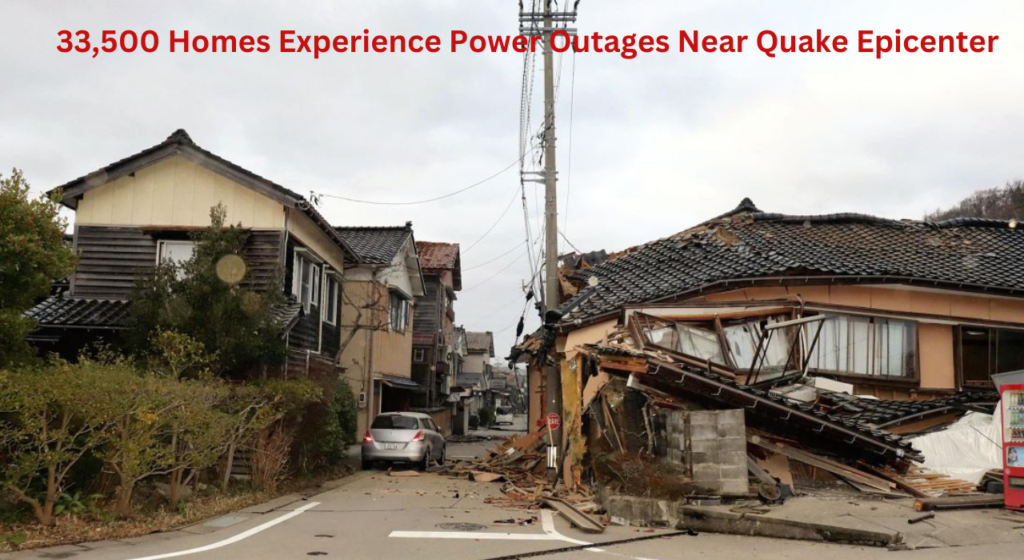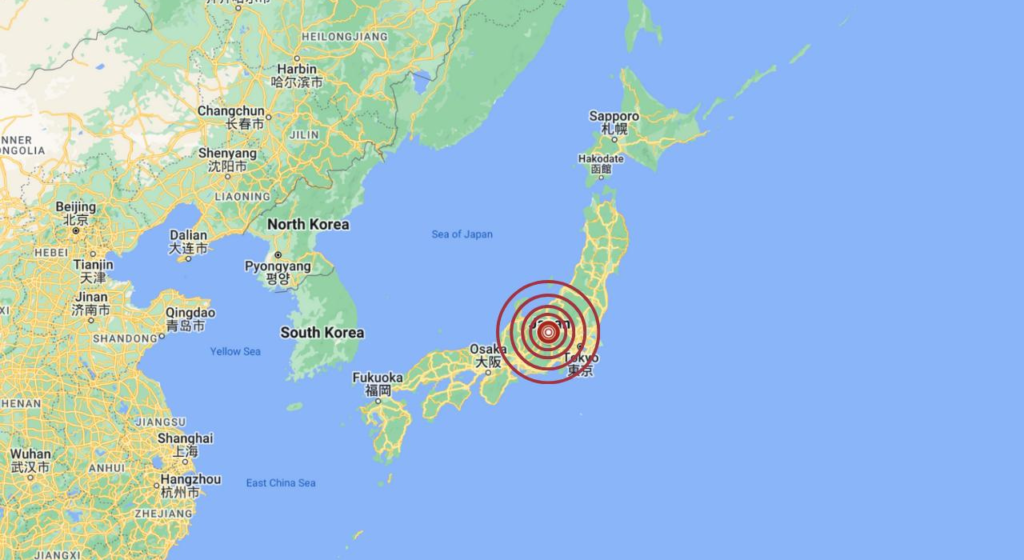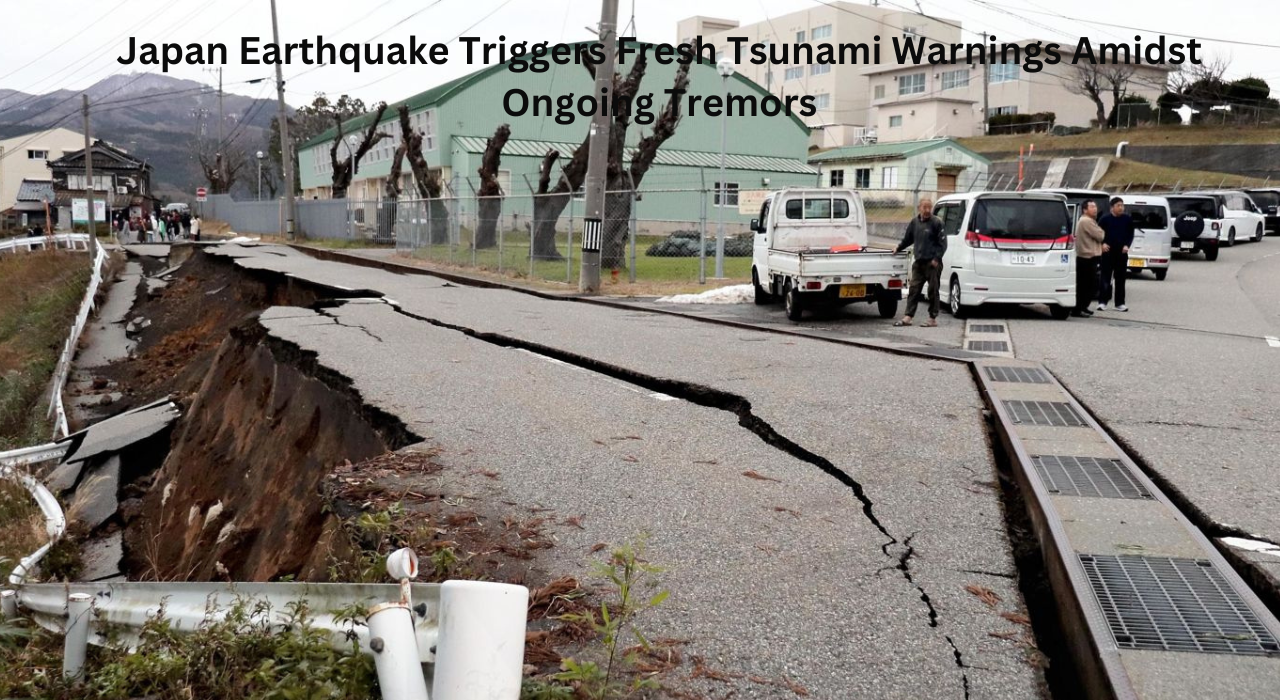A powerful earthquake, with a preliminary magnitude of 7.6, struck north-central Japan on a Monday afternoon, prompting the Japan Meteorological Agency to issue a tsunami warning for coastal areas in Ishikawa, Niigata, and Toyama prefectures. The quake, centered in Ishikawa and neighboring regions, included one measurement with a preliminary magnitude of 7.4.
The coastal city of Wajima in Ishikawa Prefecture experienced waves exceeding 1 meter in height, as reported by NHK TV. The aftermath included damage to a torii gate at a shrine in Kanazawa, Ishikawa prefecture. Urgent warnings were issued, cautioning about potential torrents of water reaching up to 5 meters (16.5 feet), prompting authorities to advise residents to seek higher ground or the tops of nearby buildings swiftly.
As of now, there are no immediate reports of casualties or damages. However, the specter of the devastating 9.0-magnitude earthquake in March 2011, which triggered a tsunami claiming around 18,500 lives, looms large in Japan’s collective memory. More recently, in March 2022, a 7.4-magnitude quake off the coast of Fukushima resulted in three casualties. These events serve as stark reminders of the seismic challenges faced by Japan, including the devastating earthquake that struck Tokyo in 1923.

- Japan on high alert as tsunami warnings are issued following a series of powerful earthquakes along its western coastline.
- The Japan Meteorological Agency registers seismic activity off the Ishikawa coast and neighboring prefectures, with one quake having a preliminary magnitude of 7.6.
Earthquake Fallout: Japan Faces Renewed Scrutiny on Nuclear Energy Choices
- Shogo Akagawa, editor-in-chief at Nikkei news agency, highlighted the fortunate circumstance that several nuclear power plants near the epicenter of the 7.6 magnitude earthquake were not operational. These plants had been shut down since the Fukushima disaster.
- Reflecting on the lingering impact of the Fukushima incident, which caused significant damage and raised international concerns due to residual radioactivity, Akagawa mentioned the ongoing debate in Japan about whether to restart nuclear plants for power generation.
- He pointed out the division in public opinion, acknowledging a shift toward pro-restart sentiments. Factors influencing this shift include concerns about energy security in the face of geopolitical tensions, such as those with Russia, a significant energy supplier to Japan. Additionally, the growing awareness of climate change plays a role in the reconsideration of nuclear energy.
Echoes of Disaster: Japan Nervously Reflects on Fukushima After Latest Earthquakes
The recent magnitude 7.4 earthquake triggered haunting memories of the 2011 catastrophe when a powerful 9.0 quake struck off Japan’s northeastern coast. This devastating event unleashed a colossal tsunami, reaching heights of up to 30 meters (98 feet), and led to the meltdown of three nuclear reactors at the Fukushima plant, ultimately obliterated by the force of the wave.
In the aftermath of the nuclear disaster, the government mandated evacuations from nearby cities and established radiation exclusion zones around the Fukushima plant. At its peak in 2012, nearly 165,000 residents were compelled to evacuate. Subsequent decontamination efforts allowed for the reopening of most areas, permitting people to return to their homes. However, despite these efforts, thousands of individuals are still categorized as Fukushima evacuees, with many expressing a steadfast reluctance to return, citing concerns about lingering radiation and their overall well-being.
Travel Chaos as Flights to Niigata, Ishikawa Face Cancellations
Japanese airline ANA made the decision to divert flights that were en route to Toyama and Ishikawa airports in light of the recent seismic activity. Simultaneously, Japan Airlines took a precautionary measure by canceling the majority of its services to the Niigata and Ishikawa regions. Authorities also reported the closure of one of Ishikawa’s airports, emphasizing the careful approach taken to ensure the safety and well-being of passengers in response to the earthquake.
Wajima City Residents Face Destruction as Fire Engulfs Multiple Homes
The earthquakes have left a trail of destruction in Japan, damaging at least six homes and trapping people inside. Wajima city in Ishikawa prefecture is grappling with a fire outbreak, leading to power outages for over 30,000 households. Government spokesperson Yoshimasa Hayashi confirmed that Japan’s military has actively joined rescue efforts to assist those affected.
Footage from Japanese media vividly depicts the chaotic scenes, with people urgently navigating the streets and red smoke billowing from a fire in a residential neighborhood. The Meteorological Agency has detected over a dozen strong quakes in the region, heightening concerns about potential landslides and the risk of houses collapsing. The situation is dynamic, and efforts are underway to address the immediate challenges and ensure the safety of those impacted by the seismic events.
Series of Quakes Sparks Rush for Essentials in Japan
Takashi Wakabayashi, a convenience store worker in Ishikawa prefecture, described the aftermath of the recent earthquake, noting that items fell from shelves. However, the more pressing concern was the influx of people rushing to stock up on essentials like bottled water, rice balls, and bread.
Wakabayashi highlighted the challenges faced by the convenience store, stating, “We have customers at three times the level of usual.” The sudden surge in demand reflects the community’s immediate response to the seismic event, emphasizing the impact on local businesses and the urgency felt by residents to secure necessities.
This earthquake comes almost 13 years after the devastating 9.0 magnitude quake that triggered a tsunami, causing widespread destruction and claiming over 18,000 lives. The scars of that tragedy still linger in the collective memory of Japan, serving as a poignant reminder of the country’s vulnerability to natural disasters and the need for swift and coordinated responses in their aftermath.
Noto Region Faces Unrivaled Earthquake Intensity
The seismic jolt of the 7.6 magnitude earthquake striking Japan stands as the most powerful recorded in the Noto Peninsula region of Ishikawa prefecture since 1885, a period encompassing the available data. This historical perspective underscores the rarity and intensity of the recent event, marking a significant seismic episode in the region.
Adding to the gravity of the situation, an official from the Japan Meteorological Agency emphasized that Monday’s earthquake triggered the issuance of a major tsunami warning, a stark reminder of the last occurrence on March 11, 2011. The resonance of this warning harks back to the devastating earthquake and tsunami of that time, etching a profound impact on the collective memory.
Furthermore, the seismic intensity of 7.0 associated with this earthquake makes it the first of such magnitude in Japan since September 2018, highlighting the infrequency of such powerful seismic events and the unique circumstances surrounding this recent occurrence.
North Korea Sends Out Alerts Amidst Rising Concerns
North Korea has joined the alert, issuing tsunami warnings for its east coast. According to reports from the South Korean Yonhap news agency, the North Korean state radio conveyed the potential threat of waves reaching up to 2.08 meters (6.8 feet) along its shore. The shared concern over potential tsunami impact underlines the collaborative efforts and regional awareness in response to the seismic activity in the neighboring waters.
Tokyo Feels Earthquake Impact from the Far Shore
Video footage captured by NHK, the broadcasting network, vividly portrays the impact of the earthquake. In Suzu, a coastal city, a building crumbles into a plume of dust, while residents in Kanazawa city can be seen seeking refuge under tables as the tremors reverberate through their homes.
The power of the quake was significant enough to jolt buildings in Tokyo, situated on the opposite coast, underscoring the widespread reach of the seismic activity. This serves as a stark reminder of Japan’s susceptibility to earthquakes, a reality ingrained in the daily lives of its residents.
Reflecting on Japan’s seismic history, the catastrophic events of March 2011 come to mind when a major quake and tsunami led to nuclear meltdowns in Fukushima. The toll was immense, with an estimated 18,400 lives lost in that temblor. The recent earthquake serves as a poignant reminder of the ongoing seismic challenges faced by the nation.
South Korea’s Eastern Province Calls for Evacuation Amid Uncertain Conditions
Residents in South Korea’s Gangwon province have been urged to take precautionary measures and evacuate to higher ground as a response to the tsunami warnings. The meteorological agency in South Korea reported that a tsunami wave measuring 0.45 meters (1.5 feet) reached the east coast of Mukho in Gangwon province. The advisory emphasized the potential for waves to increase in height after the initial impact and persist for up to 24 hours.
In light of the situation, the city of Samcheok has advised its residents to relocate to areas higher than a three-storey building, emphasizing the importance of prioritizing safety and taking proactive steps to minimize risks associated with the potential tsunami.
Agency Stresses Risk of More Major Earthquakes Over the Next Week
The Meteorological Agency delivered a comprehensive update in a nationally broadcast news conference, alerting the public to the potential for more major earthquakes in the coming week. Specifically, seismic intensity of 7 is anticipated, with a higher likelihood in the next two or three days. The agency official stressed the increased risk of fires and landslides in areas directly affected by the initial quake.
Prime Minister Fumio Kishida, in comments broadcasted on public broadcaster NHK, emphasized the ongoing assessment of the damage by authorities. He urged residents to remain vigilant and prepare for the possibility of additional tremors. The situation is dynamic, and the collaboration between officials and citizens is crucial in navigating the aftermath of this seismic event.
Urgent Evacuation Appeal – Every Minute Matters
Government spokesperson Yoshimasa Hayashi provided reassurance to reporters, stating that nuclear plants in the affected region have not reported any irregularities. However, he emphasized the critical importance of residents in coastal areas swiftly moving away from the approaching tsunami.
Hayashi conveyed a sense of urgency, saying, “Every minute counts. Please evacuate to a safe area immediately.” The anticipated tsunami, measuring about 3 meters (approximately 10 feet), is expected to impact Niigata and other prefectures along the western coast of Japan. Confirming the severity of the situation, NHK broadcaster reported smaller tsunami waves already reaching the coastline. The call to immediate action underscores the imperative nature of responding promptly to the potential threat.

Major Highways Cease Operations Due to Earthquake Impact
The earthquake’s impact has led to the closure of several major highways around the epicenter, affecting transportation infrastructure in the region. Additionally, Japan Railways announced the suspension of Shinkansen bullet train services between Tokyo and the epicenter region of Noto in Ishikawa prefecture. These disruptions underscore the immediate challenges posed by the seismic event, requiring adjustments in travel plans and highlighting the need for caution and safety measures.
33,500 Homes Experience Power Outages Near Quake Epicenter
In the aftermath of a series of significant earthquakes in central Japan, approximately 33,500 households find themselves without power around the epicenter. The affected regions include Toyama, Ishikawa, and Niigata prefectures, situated on the Sea of Japan side of Japan’s main island of Honshu. Utility companies are actively working to address the power outage, emphasizing the localized impact on residents and the ongoing efforts to restore essential services in the affected areas.
Top of Form
Russia Announces Tsunami Warning for Far Eastern Coastal Regions
Russia has taken precautionary measures in response to the seismic activity, issuing a tsunami warning for the far eastern cities of Vladivostok and Nakhodka, according to state news agency TASS, citing the cities’ mayoralties. Emergency services on Sakhalin Island, located near Japan, have also declared a “tsunami alert,” cautioning that the western coast “may be affected by tsunami waves.”
In Vladivostok, authorities have announced an alert, urging fishermen to “urgently get back to shore.” These coordinated efforts illustrate the shared commitment to public safety in the face of potential tsunami threats, highlighting the collaborative approach across borders in times of emergency.
Japan Issues Warnings for Coastal Areas in Anticipation of Tidal Waves
Japan has responded swiftly to a series of strong earthquakes along its western coastline by issuing tsunami alerts and advising coastal residents to evacuate. The Japan Meteorological Agency took decisive action, issuing a major tsunami warning specifically for Ishikawa, while lower-level warnings or advisories were extended to the rest of the western coast of Japan’s main island of Honshu.
NHK TV, a Japanese public broadcaster, emphasized the potential severity of the situation, cautioning that torrents of water could reach heights as daunting as 5 meters (16.5 feet). Urging residents to prioritize their safety, NHK advised people to swiftly move to higher ground or seek refuge at the top of nearby buildings. The comprehensive response underscores the collective effort to minimize risks and protect the well-being of those in vulnerable coastal areas.
